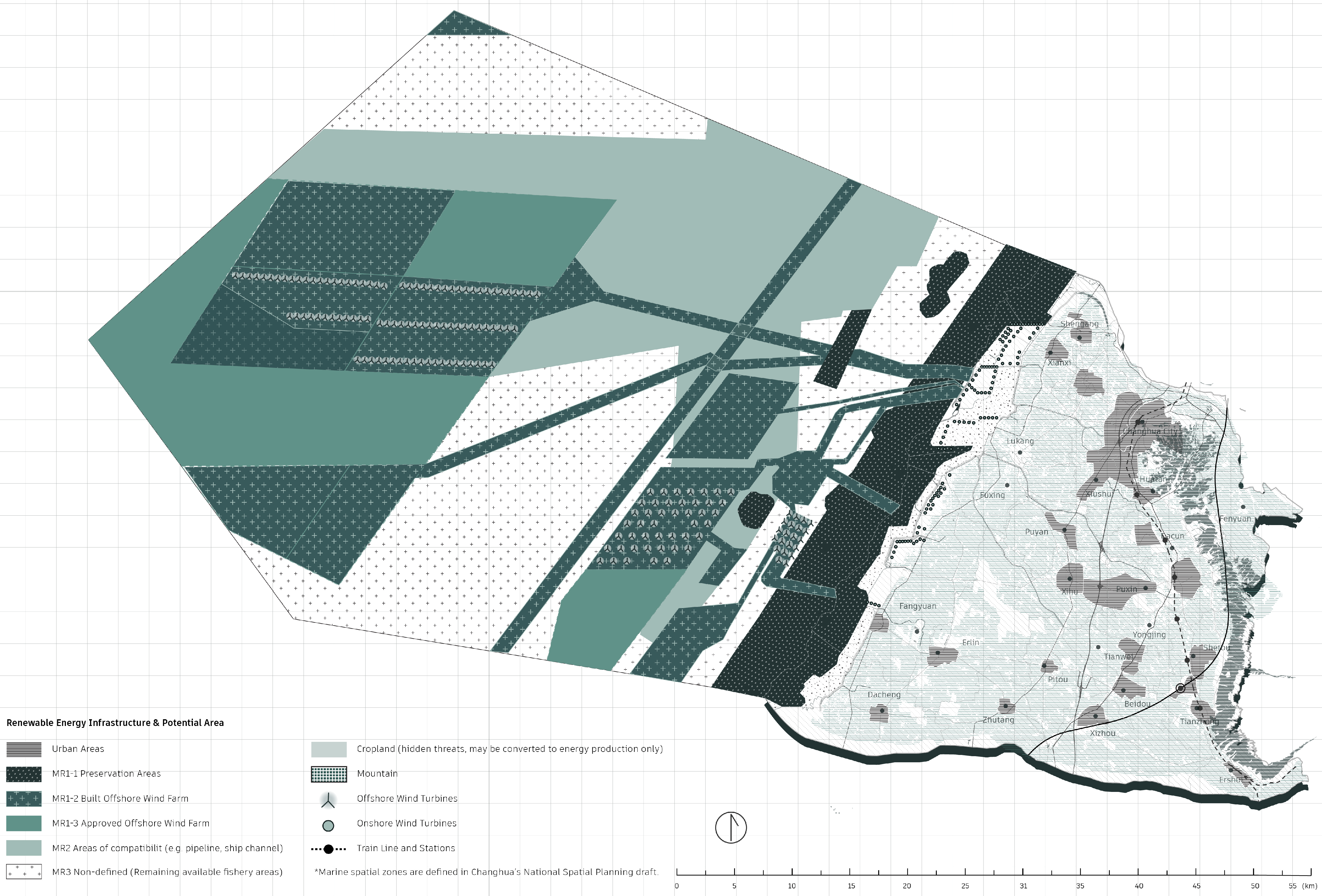Towards Just and Integrated Energy Transition in Taiwan: A Socio-Spatial Perspective
Abstract
1. Introduction
1.1. The Context: The Taiwanese Energy Plan
1.2. The Gap between the Taiwanese Energy Plan and the Separated Planning Systems
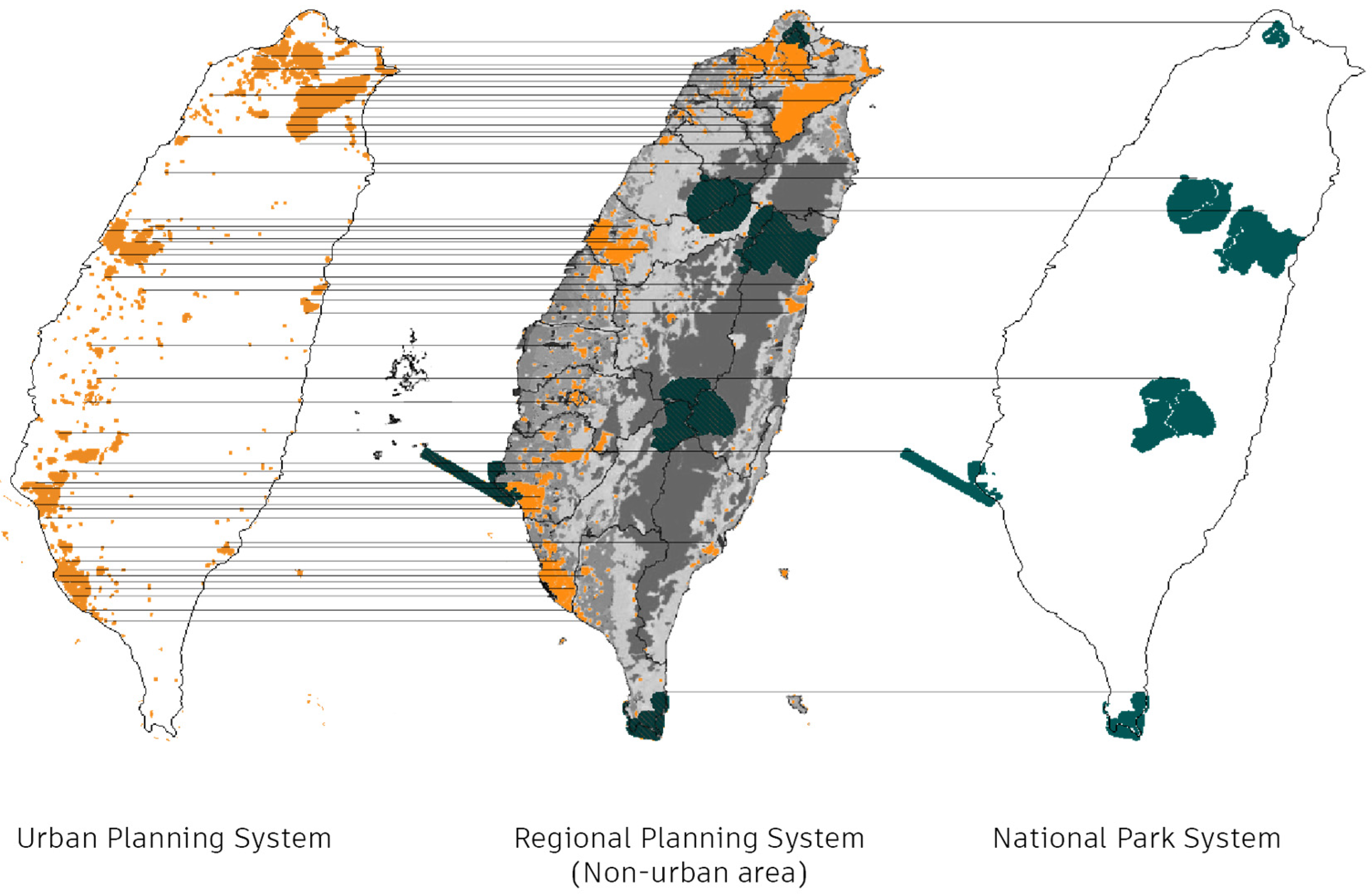
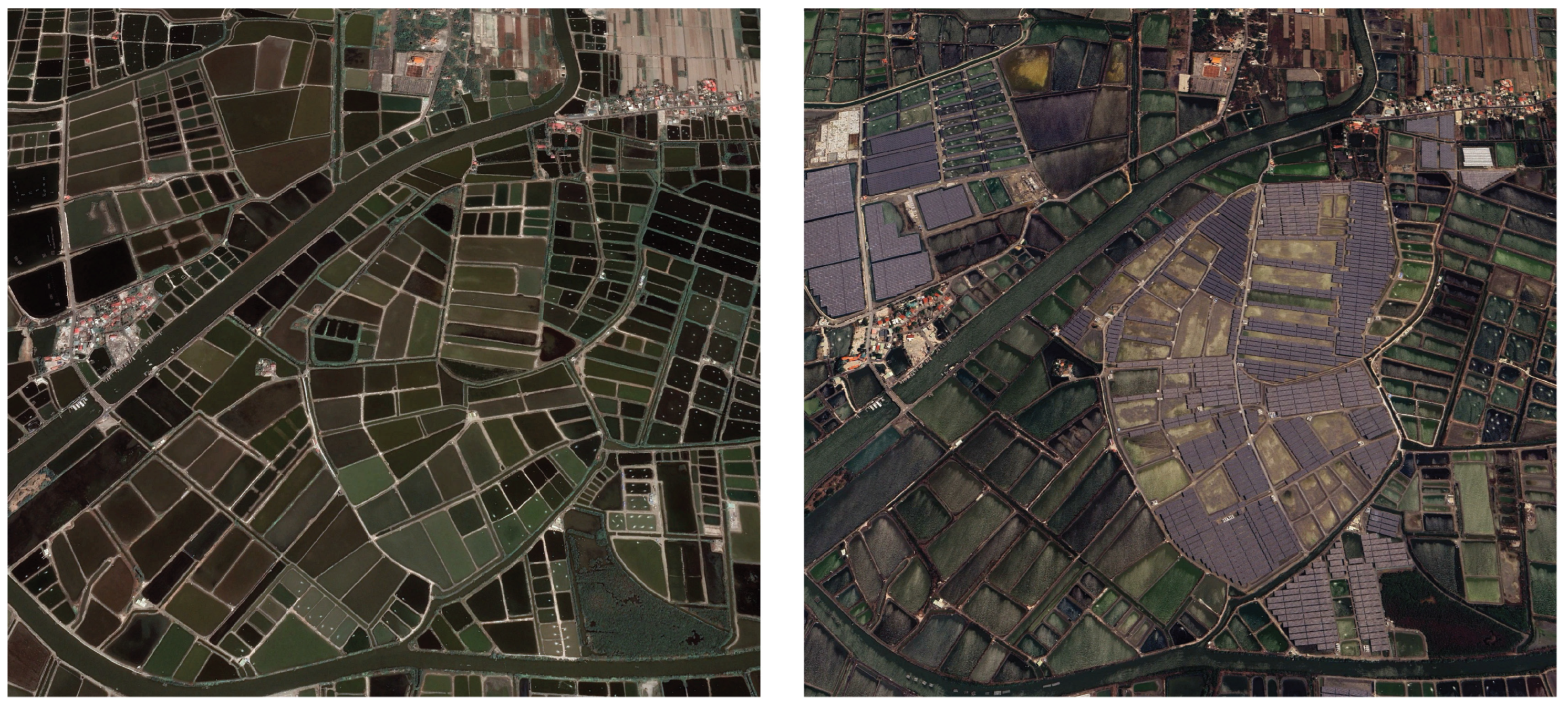
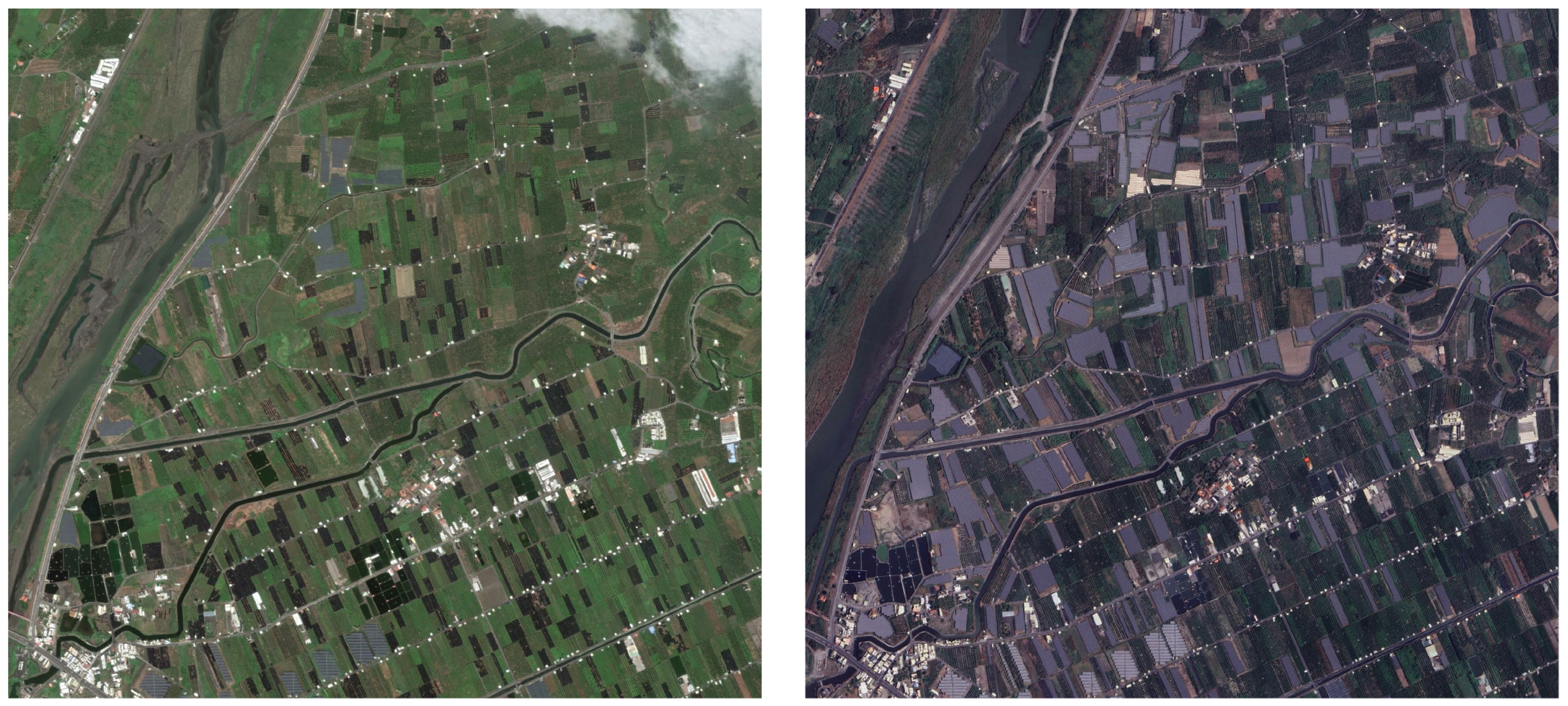
1.3. Research Question and the Article’s Structure
2. Literature Review and Conceptual Framework
2.1. Energy and Space
2.2. Spatial Justice and Energy Justice
2.3. Integrated Planning
2.4. Conceptual Framework: Integrated Planning for Spatially Just Energy Transition
3. Materials and Methods
3.1. Analysis of Transition Challenges across Taiwan
3.2. Case Study Selection: Changhua, Taiwan
3.3. Research Methods
4. Results: Unpacking the Barriers to Just Energy Transition
4.1. Institutional Barriers at the Taiwanese Scale
4.1.1. The Lack of Integrated Planning
4.1.2. The Hidden Threats for Agriculture and Aquaculture Due to Excessive Focus on Multifunctional Land Use in Non-Urban Areas
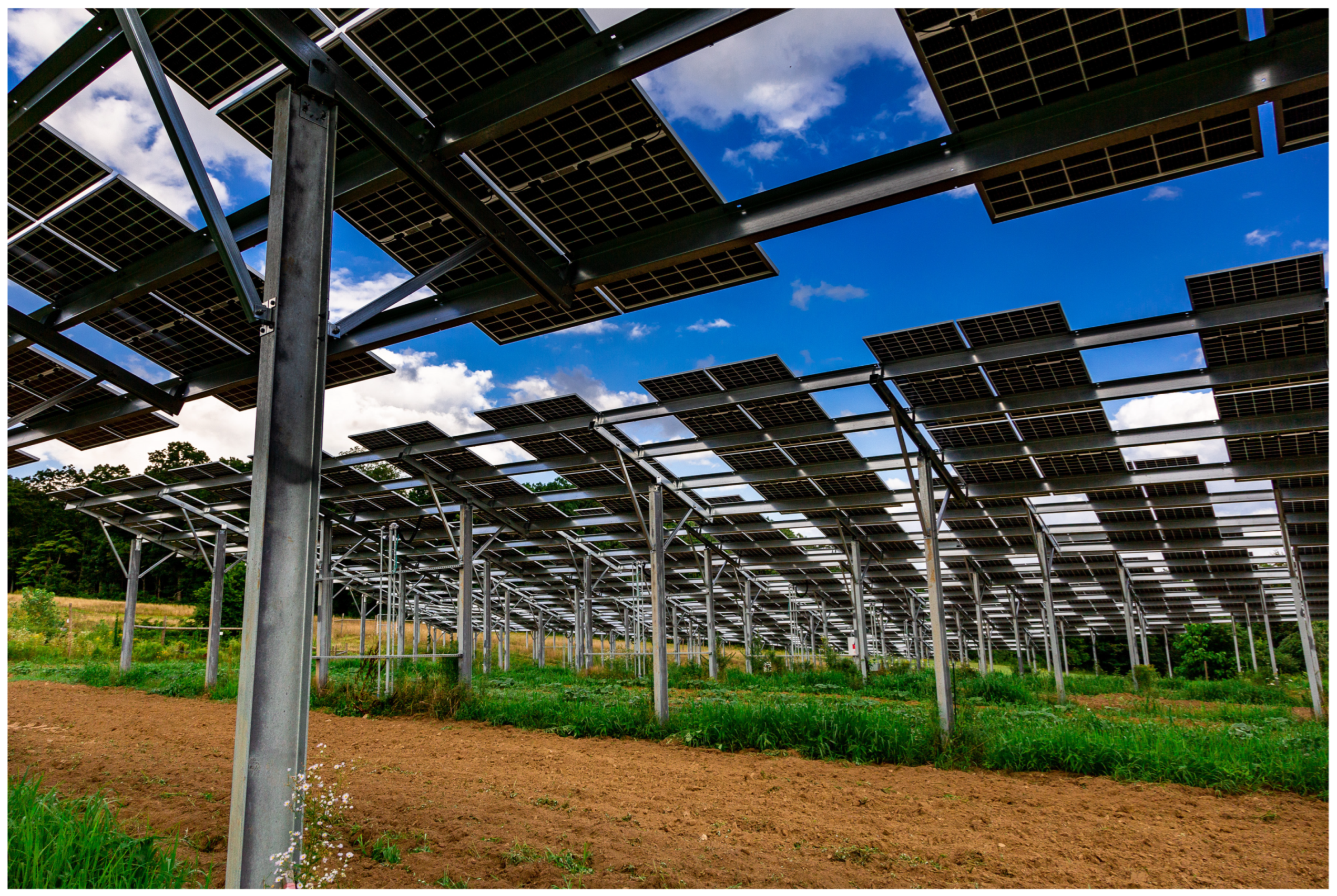
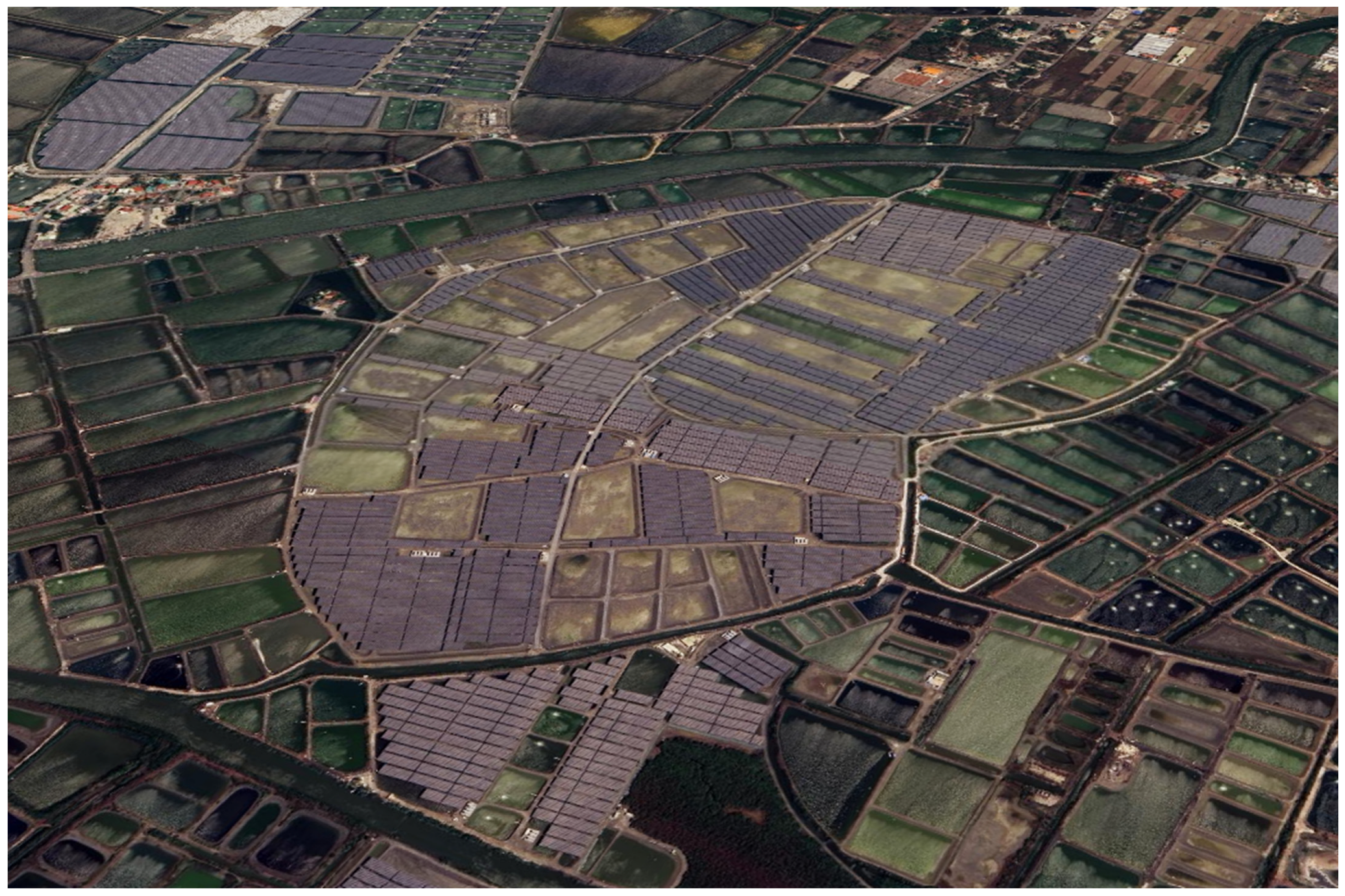
4.1.3. Lack of Understanding of the Local Scale
4.2. Socio-Spatial Barriers to Transition: The Case of Changhua
4.2.1. Central Strategies Exacerbating the Uneven Spatial and Socio-Economic Development in Changhua
4.2.2. Hidden Injustices on the Local Scale: The Marginalization of Local Stakeholders Due to Institutional Barriers
5. Discussion
5.1. Towards Integrated Spatial Planning for Energy Transition
5.1.1. Filling the Governance and Practice Gap through Integrated Planning
5.1.2. The Importance of Integrating Spatial and Social Perspectives
5.2. Seizing the Potential of the New Spatial Planning System in Taiwan
5.3. Limitations and Future Research
6. Conclusions
6.1. Main Findings
6.2. Contribution to the Literature
6.2.1. A Framework for Rethinking Just Energy Transition through Socio-Spatial Lens
6.2.2. Rethinking Rural–Urban Relations for Just Energy Transition
Author Contributions
Funding
Data Availability Statement
Acknowledgments
Conflicts of Interest
References
- Sovacool, B.K.; Dworkin, M.H. Energy Justice: Conceptual Insights and Practical Applications. Appl. Energy 2015, 142, 435–444. [Google Scholar] [CrossRef]
- Chen, Y.-F.; Chin, J. Solar Development Harming Farmers, Academics Say—Taipei Times. Taipei Times. 2023, p. 2. Available online: https://www.taipeitimes.com/News/taiwan/archives/2023/06/21/2003801903 (accessed on 9 June 2024).
- Lin, Y. When Light and Power Surrounds a Fishing Village: What Are Residents Protesting Against in the Seven Streams of Fish-Power Co-Sustainability? The Reporter 2022. Available online: https://www.twreporter.org/a/qigu-fishery-electricity-symbiosis (accessed on 9 June 2024).
- Gao, A.M.; Fan, C.T.; Liao, C.N. Application of German energy transition in Taiwan: A critical review of unique electricity liberalization as a core strategy to achieve renewable energy growth. Energy Policy 2018, 120, 644–654. [Google Scholar] [CrossRef]
- Executive Yuan. Energy Transition White Paper; Executive Yuan: Taipei, Taiwan, 2020. Available online: https://energywhitepaper.tw/#/whitepaper (accessed on 9 June 2024).
- Bureau of Energy (MOEA). Energy Statistics Handbook 2020. 2022. Available online: https://www.moeaboe.gov.tw/ECW_WEBPAGE/FlipBook/2020EnergyStaHandBook/index.html#p= (accessed on 9 June 2024).
- Gao, A.M.; Kuang, Y.T.; Chen, J.S. An unjust and failed energy transition strategy? Taiwan’s goal of becoming nuclear-free by 2025. Energy Strategy Rev. 2022, 44, 100991. [Google Scholar] [CrossRef]
- Lien, W.W. A Landscape Approach to the Conflicts of Greens: Planning for Energy and Wetland Land-Use Growth in Southwestern Taiwan’s Coastal Landscape in a Climate-Changing Era. 2021. Available online: https://scholarsbank.uoregon.edu/xmlui/handle/1794/26129 (accessed on 9 June 2024).
- Hsu, C.H.; Chou, J.Y.; Fang, W.T. Habitat selection of wintering birds in farm ponds in Taoyuan, Taiwan. Animals 2019, 9, 113. [Google Scholar] [CrossRef] [PubMed]
- Ministry of Agriculture Annual Report of Agricultural Statistics in 2022; Ministry of Agriculture: Taipei, Taiwan, 2022. Available online: https://agrstat.moa.gov.tw/sdweb/public/book/Book.aspx (accessed on 6 March 2024).
- Bureau of Energy Energy White Paper; Ministry of Economic Affairs. Available online: https://energywhitepaper.tw/pdf/1091118_energy_whitepaper.pdf (accessed on 9 June 2024).
- Lefebvre, H. The Production of Space; Blackwell: Oxford, UK; Cambridge, MA, USA, 1991. [Google Scholar]
- Massey, D.B. For Space; Sage: London, UK, 2005. [Google Scholar]
- Lin, J.; Cai, J. What is Blowing in the Wind: How Do the Government, Fisheries Associations and Developers Respond to the Controversy over Wind Power? NewsMarket. 2021. Available online: https://today.line.me/tw/v2/article/oejOJj (accessed on 9 June 2024).
- Lin, G. Green Energy Zones in a Hurry, National Spatial Planning Has Been Hollowed out. More than 100 Experts and Scholars Co-Sign to Oppose the Ministry of the Interior’s Guide for the Rational Use of National Land. News Market. 2023. Available online: https://www.newsmarket.com.tw/blog/188203/ (accessed on 9 June 2024).
- Zhang, Y.; Zhang, C.; Chang, Y.; Liu, W.; Zhang, Y. Offshore wind farm in marine spatial planning and stakeholder engagement: Opportunities and challenges for Taiwan. Ocean. Coast. Manag. 2017, 149, 69–80. [Google Scholar] [CrossRef]
- National Land Surveying and Mapping Centre Datasheet of 2021 Ordnance Survey Topographic Map Values (Scale 25,000) (SHP File) [Dataset]. Available online: https://data.gov.tw/dataset/152109 (accessed on 9 June 2024).
- Google Earth. Tainan, 23°7′6.924″ N 120°6′36.3604″ E 2023. Available online: https://earth.google.com/ (accessed on 9 June 2024).
- Google Earth. Pintung, 22°26′27.2508″ N 120°32′0.2908″ E 2023. Available online: https://earth.google.com/ (accessed on 9 June 2024).
- Strategic Plan for National Spatial Development. Ministry of Interior. 2010. Available online: https://ws.ndc.gov.tw/Download.ashx?u=LzAwMS9hZG1pbmlzdHJhdG9yLzEwL1JlbEZpbGUvNTU2Ni83MTk3LzAwMTE3ODBfNi5wZGY%3d&n=57aT5bu65pyD5ZyL5ZyfX%2bS4reaWh1IucGRm&icon=.pdf (accessed on 9 June 2024).
- Taiwan Sustainability Hub. (Renewable Energy and Land Planning (Part 1): An Overall Framework for Resolving the “Green Conflict”). TSH. 2023. Available online: https://www.taiwansustainabilityhub.org/post/%E5%86%8D%E7%94%9F%E8%83%BD%E6%BA%90%E8%88%87%E5%9C%8B%E5%9C%9F%E8%A8%88%E7%95%AB%EF%BC%88%E4%B8%8A%EF%BC%89%EF%BC%9A%E5%8C%96%E8%A7%A3%E3%80%8C%E7%B6%A0%E8%89%B2%E8%A1%9D%E7%AA%81%E3%80%8D%E7%9A%84%E6%95%B4%E9%AB%94%E6%A1%86%E6%9E%B6 (accessed on 9 June 2024).
- Energy Justice Transition Oversight Group, National Cheng Kung University Urban Planning Department. Our Statement on a Just Energy Transition: Plan, Cite, Regulate, Collaborate, and Achieve a Pathway that Balances Photovoltaic Development with a Just Transition [Press Release]. 2023. Available online: https://drive.google.com/file/d/1q1icdFY51TsWaLyXXCE-08S9Ig-VIL9u/view (accessed on 9 June 2024).
- Dikeç, M. Justice and the Spatial Imagination. Environ. Plan A 2001, 33, 1785–1805. [Google Scholar] [CrossRef]
- Soja, E.W. Seeking Spatial Justice; University of Minnesota Press: Minneapolis, MN, USA, 2013; Volume 16, ISBN 1-4529-1528-8. [Google Scholar]
- Alderman, D.H.; Inwood, J. Street Naming and the Politics of Belonging: Spatial Injustices in the Toponymic Commemoration of Martin Luther King Jr. Soc. Cult. Geogr. 2013, 14, 211–233. [Google Scholar] [CrossRef]
- Jenkins, K.; McCauley, D.; Heffron, R.; Stephan, H.; Rehner, R. Energy Justice: A Conceptual Review. Energy Res. Soc. Sci. 2016, 11, 174–182. [Google Scholar] [CrossRef]
- Garvey, A.; Norman, J.B.; Büchs, M.; Barrett, J. A “Spatially Just” Transition? A Critical Review of Regional Equity in Decarbonisation Pathways. Energy Res. Soc. Sci. 2022, 88, 102630. [Google Scholar] [CrossRef]
- European Environment Agency. European Environment Agency Delivering Justice in Sustainability Transitions; European Environment Agency: Brussels, Belgium, 2023. [Google Scholar]
- McCauley, D.; Heffron, R.J.; Stephan, H.; Jenkins, K. Advancing Energy Justice: The Triumvirate of Tenets. Law Philos. J. Artic. 2013, 32, 107–110. Available online: https://dspace.stir.ac.uk/bitstream/1893/18349/1/IELR%202013.pdf (accessed on 9 June 2024).
- Energy Poverty Observatory Energy Poverty Observatory. Available online: https://energy-poverty.ec.europa.eu/ (accessed on 11 March 2024).
- European Commission The Just Transition Mechanism. Available online: https://commission.europa.eu/strategy-and-policy/priorities-2019-2024/european-green-deal/finance-and-green-deal/just-transition-mechanism_en (accessed on 6 March 2024).
- UNFCCC. UN Agencies Support the Just Energy Transition in Asia. Available online: https://unfccc.int/news/un-agencies-support-the-just-energy-transition-in-asia (accessed on 11 March 2024).
- McCauley, D.; Pettigrew, K. Building a Just Transition in Asia-Pacific: Four Strategies for Reducing Fossil Fuel Dependence and Investing in Clean Energy. Energy Policy 2023, 183, 113808. [Google Scholar] [CrossRef]
- Hu, Z. When Energy Justice Encounters Authoritarian Environmentalism: The Case of Clean Heating Energy Transitions in Rural China. Energy Res. Soc. Sci. 2020, 70, 101771. [Google Scholar] [CrossRef]
- Counsell, D.; Allmendinger, P.; Haughton, G.; Vigar, G. Integrated Spatial Planning—Is It Living up to Expectations? Town Ctry. Plan. 2006, 75, 243. [Google Scholar]
- Nadin, V.; Stead, D.; Dąbrowski, M.; Fernandez-Maldonado, A.M. Integrated, Adaptive and Participatory Spatial Planning: Trends across Europe. Reg. Stud. 2021, 55, 791–803. [Google Scholar] [CrossRef]
- United Nations. Development Programme Integrated Spatial Planning Workbook; UNDP: New York, NY, USA, 2022. [Google Scholar]
- La Greca, P.; Martinico, F.D. Smart Energy in the Smart City: Urban Planning for a Sustainable Future; Springer: Cham, Switzerland, 2016; pp. 43–59. ISBN 3319311557. [Google Scholar]
- De Pascali, P.; Bagaini, A. Energy Transition and Urban Planning for Local Development. A Critical Review of the Evolution of Integrated Spatial and Energy Planning. Energies 2018, 12, 35. [Google Scholar] [CrossRef]
- Asarpota, K.; Nadin, V. Energy Strategies, the Urban Dimension, and Spatial Planning. Energies 2020, 13, 3642. [Google Scholar] [CrossRef]
- Stoeglehner, G.; Neugebauer, G.; Erker, S.; Narodoslawsky, M. Integrated Spatial and Energy Planning; SpringerBriefs in Applied Sciences and Technology; Springer International Publishing: Cham, Switzerland, 2016; ISBN 978-3-319-31868-4. [Google Scholar]
- Stoeglehner, G. Integrated Spatial and Energy Planning: A Means to Reach Sustainable Development Goals. Evol. Inst Econ Rev 2020, 17, 473–486. [Google Scholar] [CrossRef]
- Changhua County Government. Introduction to Changhua Green Energy Master Plan. 2019. Available online: https://files.chcg.gov.tw/files/%E5%BD%B0%E5%8C%96%E7%B6%A0%E8%83%BD%E7%B8%BD%E9%AB%94%E8%A8%88%E7%95%AB%E7%B0%A1%E4%BB%8B (accessed on 9 June 2024).
- Changhua County Government. 2021 Changhua County Key Statistical Indicators. 2021. Available online: https://www2.chcg.gov.tw/main/files/16_20231201140234139_110%E5%B9%B4%E5%BD%B0%E5%8C%96%E7%B8%A3%E5%90%84%E9%84%89%E9%8E%AE%E5%B8%82%E9%87%8D%E8%A6%81%E7%B5%B1%E8%A8%88%E6%8C%87%E6%A8%9920231201.pdf (accessed on 9 June 2024).
- Ministry of Economic Affairs Energy Statistics Handbook; Ministry of Economic Affairs: Taipei, Taiwan, 2020. Available online: https://www.moeaea.gov.tw/ECW_WEBPAGE/FlipBook/2022EnergyStaHandBook/index.html#p= (accessed on 9 June 2024).
- National Statistics. Inquiry System for Important Statistical Indicators of Counties and Municipalities [Dataset]. 2020. Available online: https://winstacity.dgbas.gov.tw/DgbasWeb/ZWeb/StateFile_ZWeb.aspx (accessed on 9 June 2024).
- News & market. Fake agriculture, real power planting, centralized mess, hard to collect locally. News Mark. 2015. Available online: https://www.newsmarket.com.tw/blog/75365/ (accessed on 9 June 2024).
- Toledo, C.; Scognamiglio, A. Agrivoltaic Systems Design and Assessment: A Critical Review, and a Descriptive Model towards a Sustainable Landscape Vision (Three-Dimensional et al.). Sustainability 2021, 13, 6871. [Google Scholar] [CrossRef]
- Fisheries Research Institute Fishery and Electricity Symbiosis—A Win-Win Situation of Combining Farming and Photoelectricity; Ministry of Agriculture: Taipei, Taiwan, 2019. Available online: https://en.tfrin.gov.tw/News_Content.aspx?n=335&s=57011 (accessed on 9 June 2024).
- News & Market. The Fishermen of the Seven Units Roared, The fisheries and Electricity Symbiosis Plundered the Farmland, the Landlords Canceled the Contract, and the Farmers were in a Survival Crisis. News & Market. 2019. Available online: https://www.newsmarket.com.tw/blog/120135/ (accessed on 9 June 2024).
- News & Market. Indoor fishing and electricity, exempted from environmental impact assessment, cockroaches in earth backfilling. News & Market. 2023. Available online: https://www.newsmarket.com.tw/west-coast-solar/ch04/ (accessed on 9 June 2024).
- Chiu, Y.-H. Site Selection and Suitability Analysis for Aquavoltaic System in Taiwan; Feng Chia University: Taichung, Taiwan, 2021. [Google Scholar]
- Karr, N. Elevated Racking System at Grafton Solar to Accommodate Specialty Crop Growth. 2022. Available online: https://www.flickr.com/photos/agrisolarclearinghouse/52341272195/ (accessed on 9 June 2024).
- Google Earth. Tainan, 23°07′09.0″ N 120°06′34.0″ E 2023. Available online: https://earth.google.com/ (accessed on 9 June 2024).
- Lai, M.C.; Wu, P.I.; Liou, J.L.; Chen, Y.; Chen, H.H. The impact of promoting renewable energy in Taiwan — How much hail is added to snow in farmland prices? J. Clean. Prod. 2019, 241, 118519. [Google Scholar] [CrossRef]
- News Lens. Small-scale aquaculture farmers cannot afford the Ten Times Land Rent which Results from solar PV development. News Lens. 2017. Available online: https://www.thenewslens.com/article/99625 (accessed on 9 June 2024).
- News & Market. Offshore Wind Power Threatens Dolphins and Fishermen, Environmental Group Criticizes: EIA is the Worst in the World, EPD Becomes an Accomplice to Greenwashing. News & Market. 2023. Available online: https://www.newsmarket.com.tw/blog/181897/#:~:text=%E5%8F%B0%E7%81%A3%E8%A5%BF%E5%B2%B8%E6%B5%B7%E5%9F%9F%E7%9A%84%E4%BF%9D%E8%82%B2,%E8%A6%8F%E5%AE%9A%E8%80%8C%E9%80%B2%E8%A1%8C%E8%A3%81%E7%BD%B0%E3%80%82 (accessed on 9 June 2024).
- Tsai, H.; Tseng, H.; Huang, C.; Yu, S. Review on the Conflicts between Offshore Wind Power and Fishery Rights: Marine Spatial Planning in Taiwan. Energies 2022, 15, 8768. [Google Scholar] [CrossRef]
- Department of Accounting and Statistics Changhua County Statistical Database [Dataset] 2021. 2021.
- Devine-Wright, P. Renewable Energy and the Public: From NIMBY to Participation; Routledge & CRC Press: Boca Raton, FL, USA, 2011. [Google Scholar]
- Executive Yuan. Preliminary Results of the Agriculture, Forestry, Fisheries and Livestock Census Summary Analysis in 2022; Executive Yuan: Taipei, Taiwan, 2022.
- Plutzer, E.; Ojeda, C. Pathways from poverty to participation. Russell Sage Found. 2013. Available online: https://www.russellsage.org/awarded-project/pathways-poverty-to-participation (accessed on 9 June 2024).
- Milligan, K.; Moretti, E.; Oreopoulos, P. Does Education Improve Citizenship? Evidence from the United States and the United Kingdom. J. Public Econ. 2004, 88, 1667–1695. [Google Scholar] [CrossRef]
- Changhua County Government. National Land Functional Zoning Map of Changhua County (Public Exhibition Draft); Changhua County Government: Changhua, Taiwan, 2023. Available online: https://land.chcg.gov.tw/files/32_20230616131841671_%e5%9c%8b%e5%9c%9f%e5%8a%9f%e8%83%bd%e5%88%86%e5%8d%80%e5%9c%96111111.pdf (accessed on 9 June 2024).
- Ministry of Interior. Functional Land Zoning. 2024. Available online: https://www.nlma.gov.tw/%E6%9C%80%E6%96%B0%E6%B6%88%E6%81%AF/%E6%A5%AD%E5%8B%99%E6%96%B0%E8%A8%8A/33394-%E5%9C%8B%E5%9C%9F%E5%8A%9F%E8%83%BD%E5%88%86%E5%8D%80%E5%8A%83%E8%A8%AD%E5%B0%88%E5%8D%80.html (accessed on 9 June 2024).
- Wolsink, M. Social Acceptance Revisited: Gaps, Questionable Trends, and an Auspicious Perspective. Energy Res. Soc. Sci. 2018, 46, 287–295. [Google Scholar] [CrossRef]
- Firestone, J.; Bates, A.; Knapp, L.A. See Me, Feel Me, Touch Me, Heal Me: Wind Turbines, Culture, Landscapes, and Sound Impressions. Land Use Policy 2015, 46, 241–249. [Google Scholar] [CrossRef]
- Delicado, A.; Figueiredo, E.; Silva, L. Community Perceptions of Renewable Energies in Portugal: Impacts on Environment, Landscape and Local Development. Energy Res. Soc. Sci. 2016, 13, 84–93. [Google Scholar] [CrossRef]
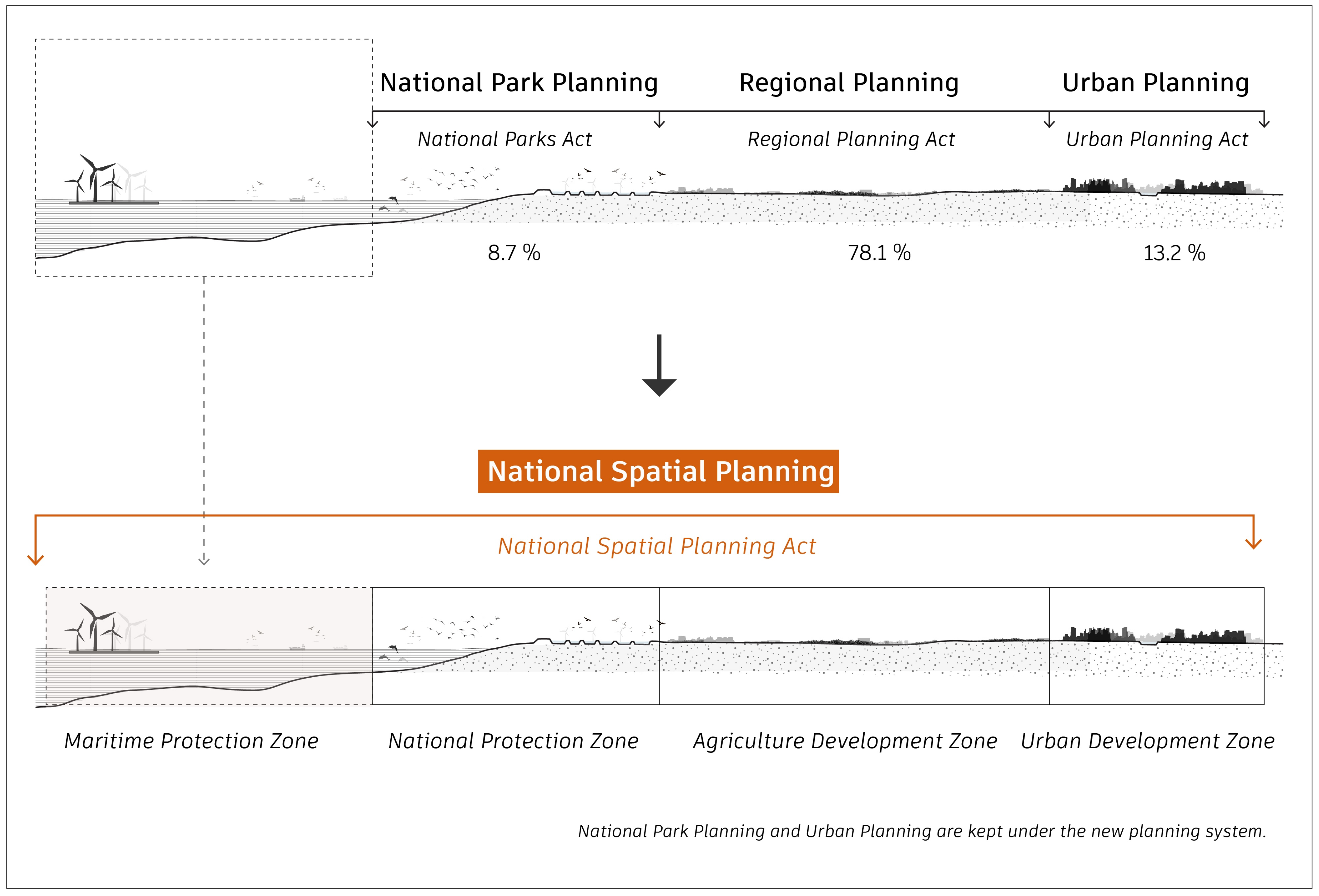
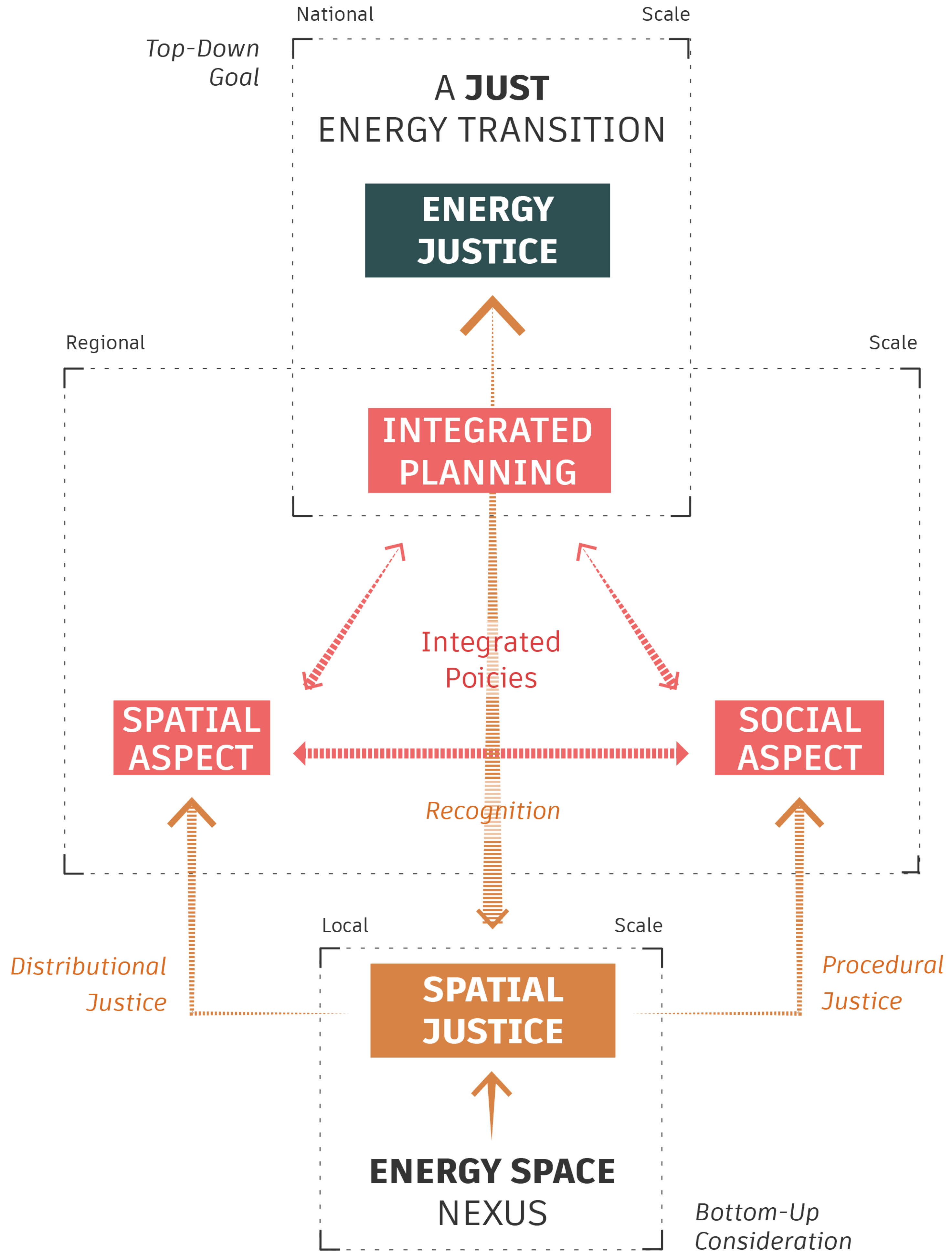
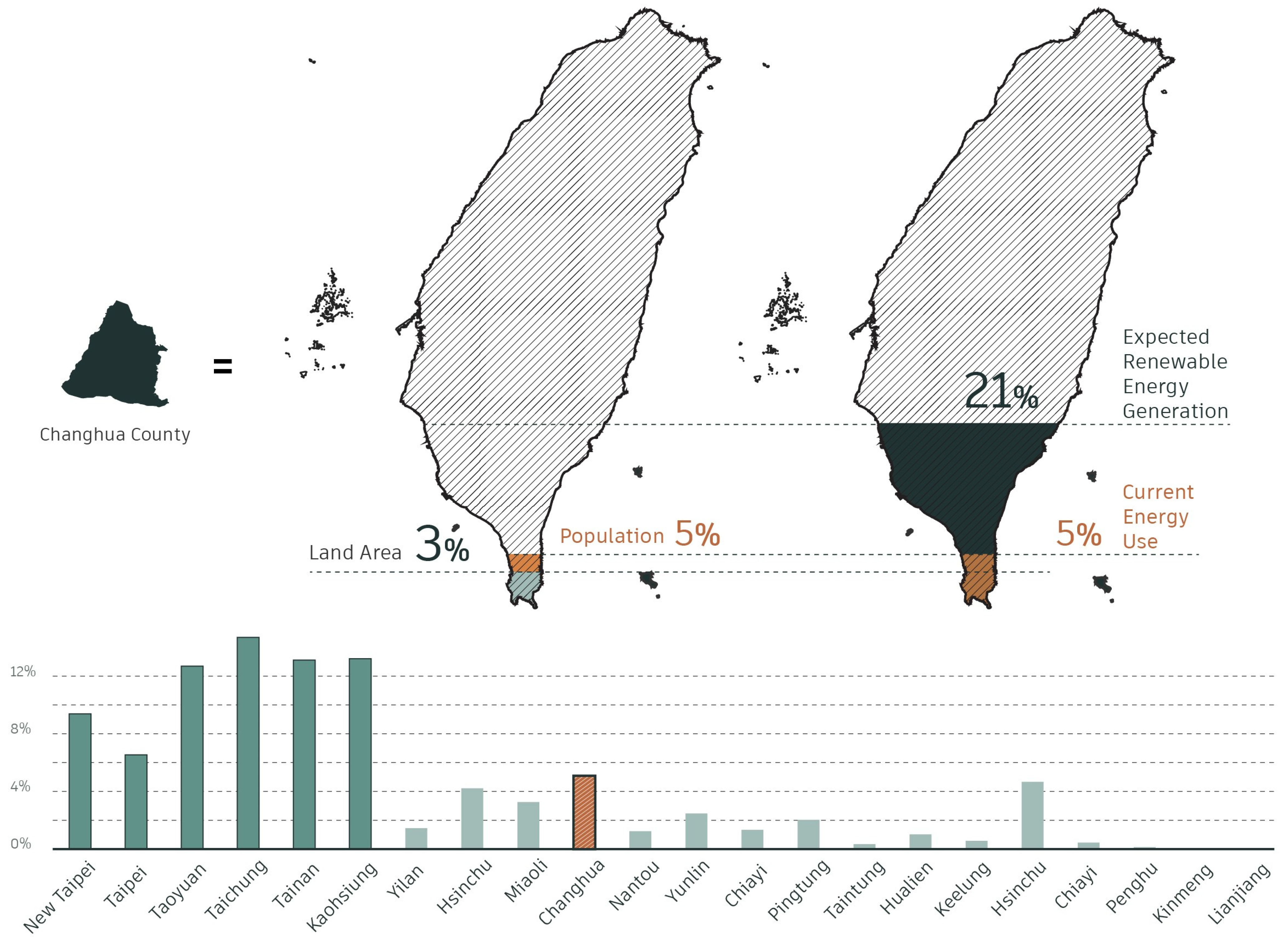
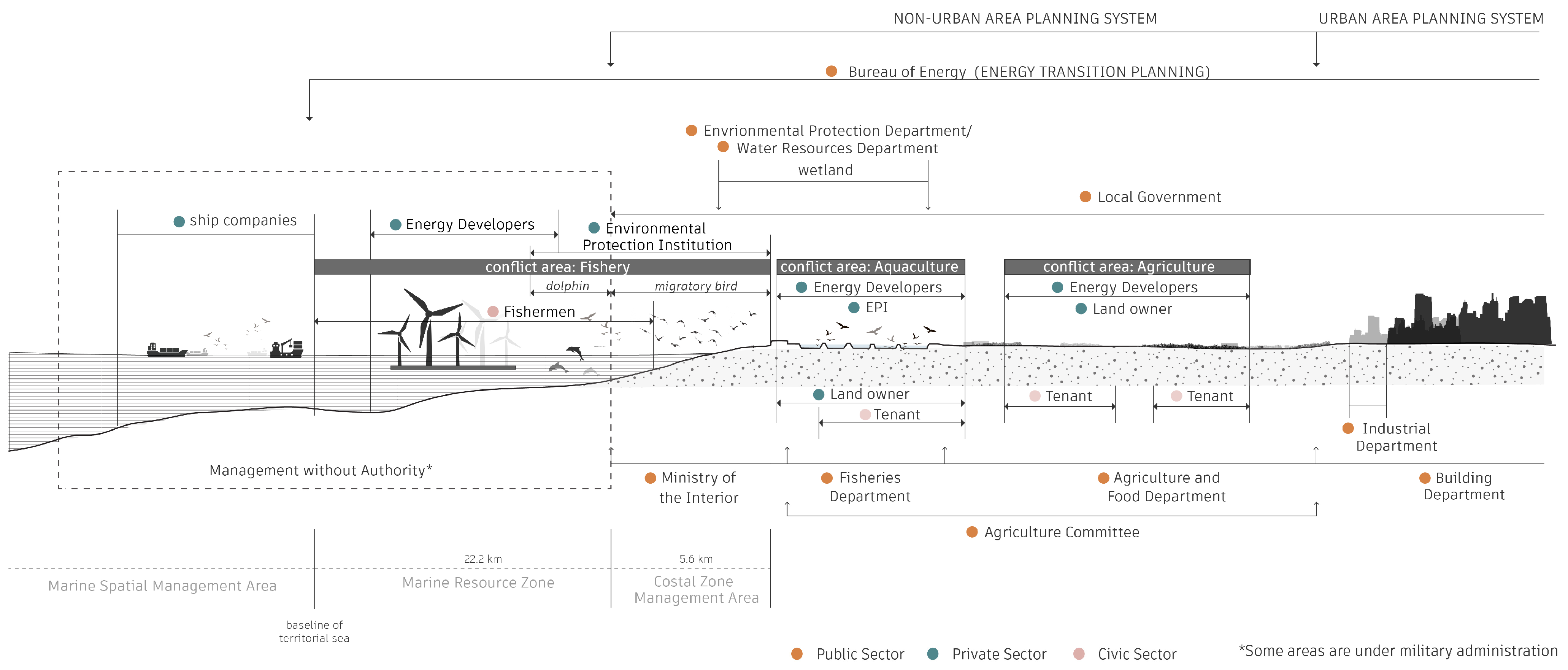
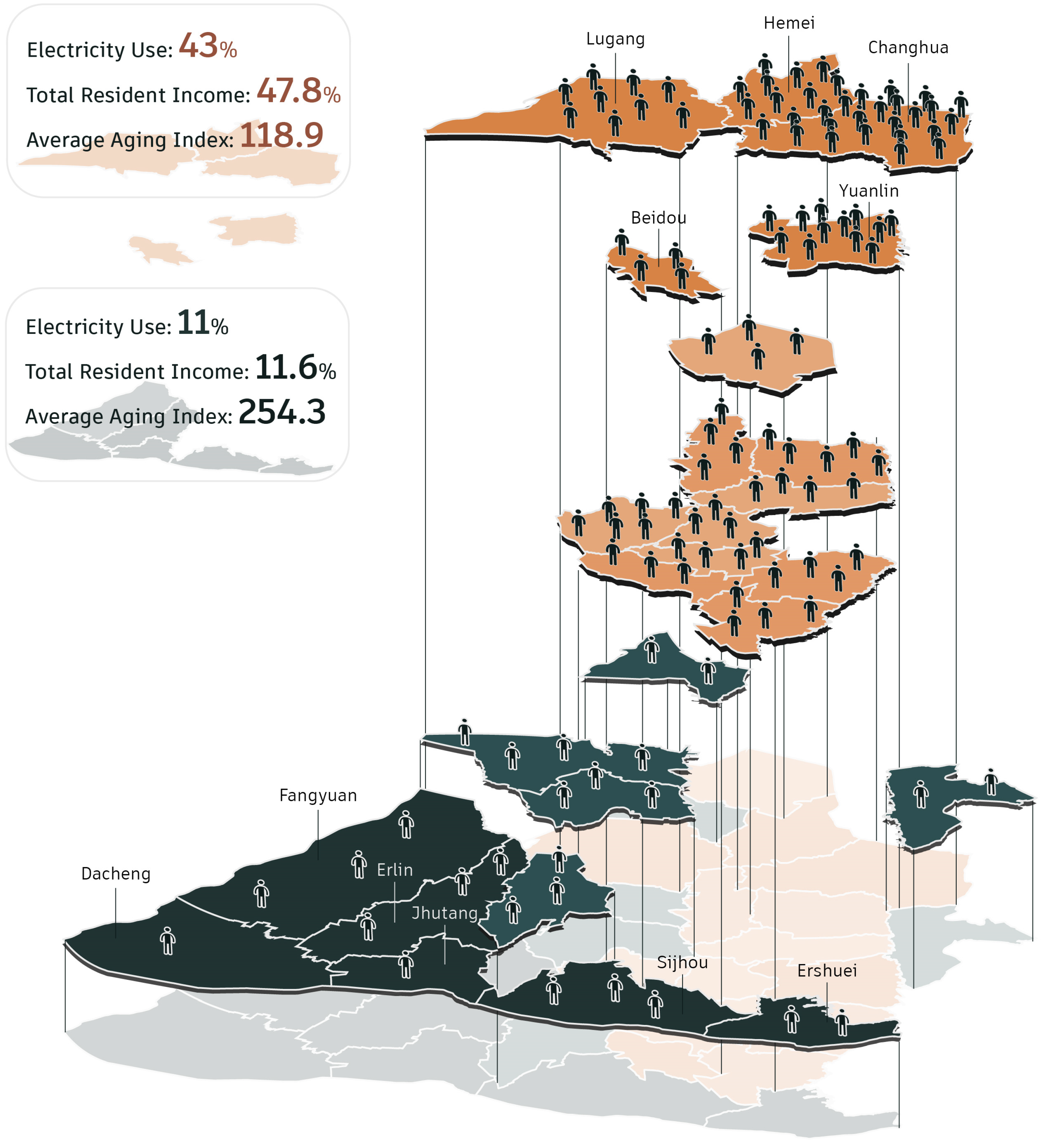
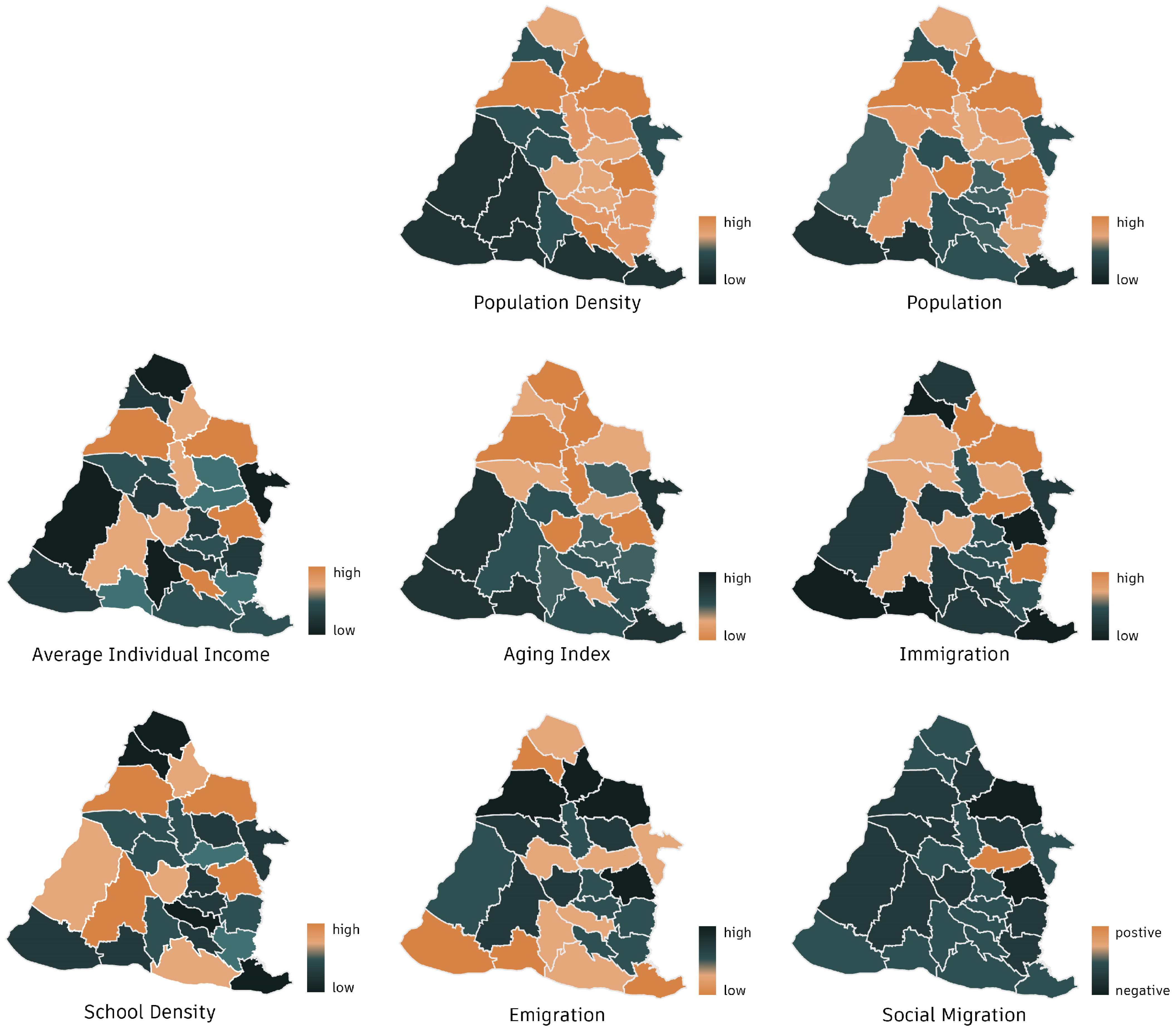
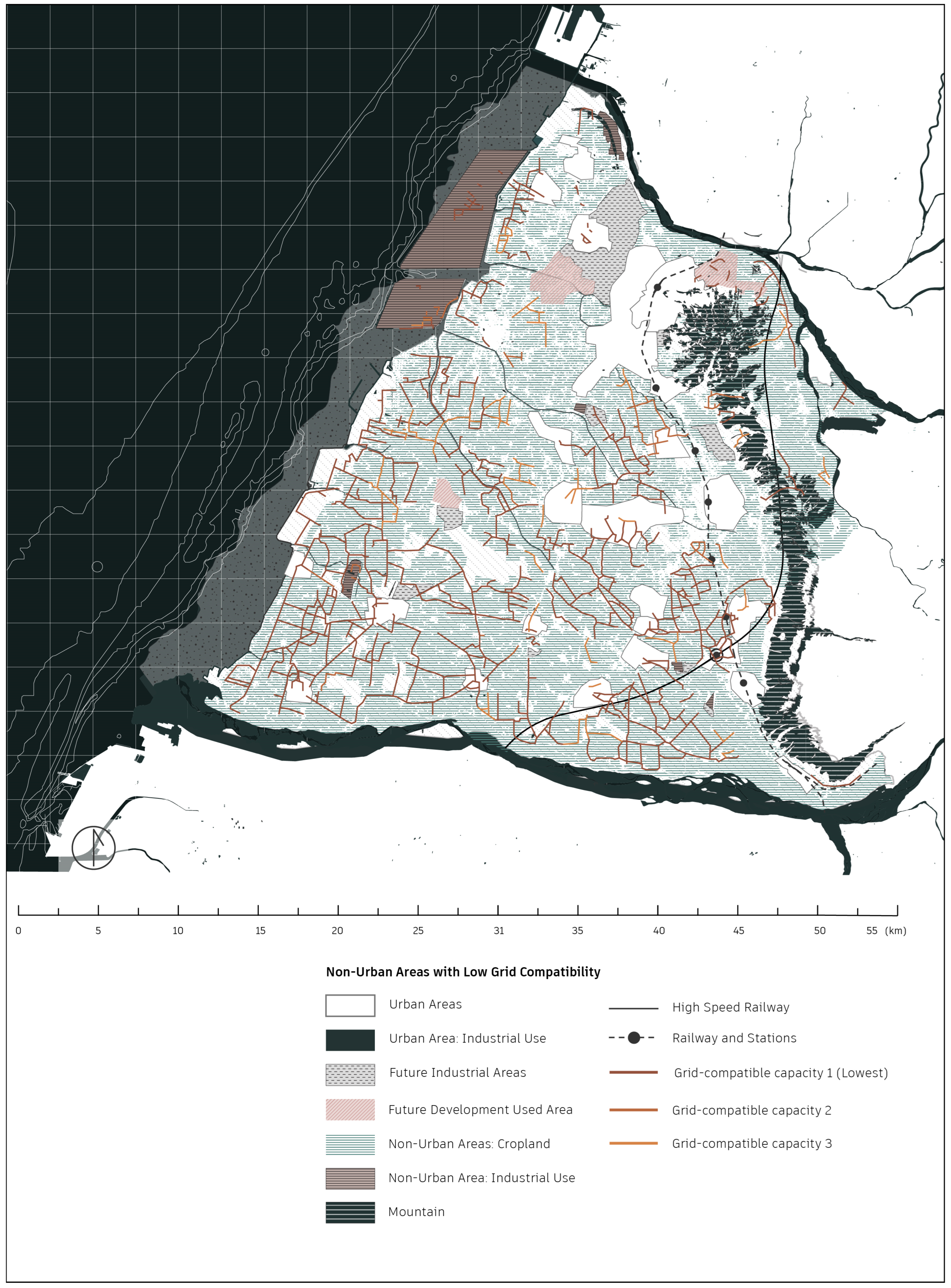
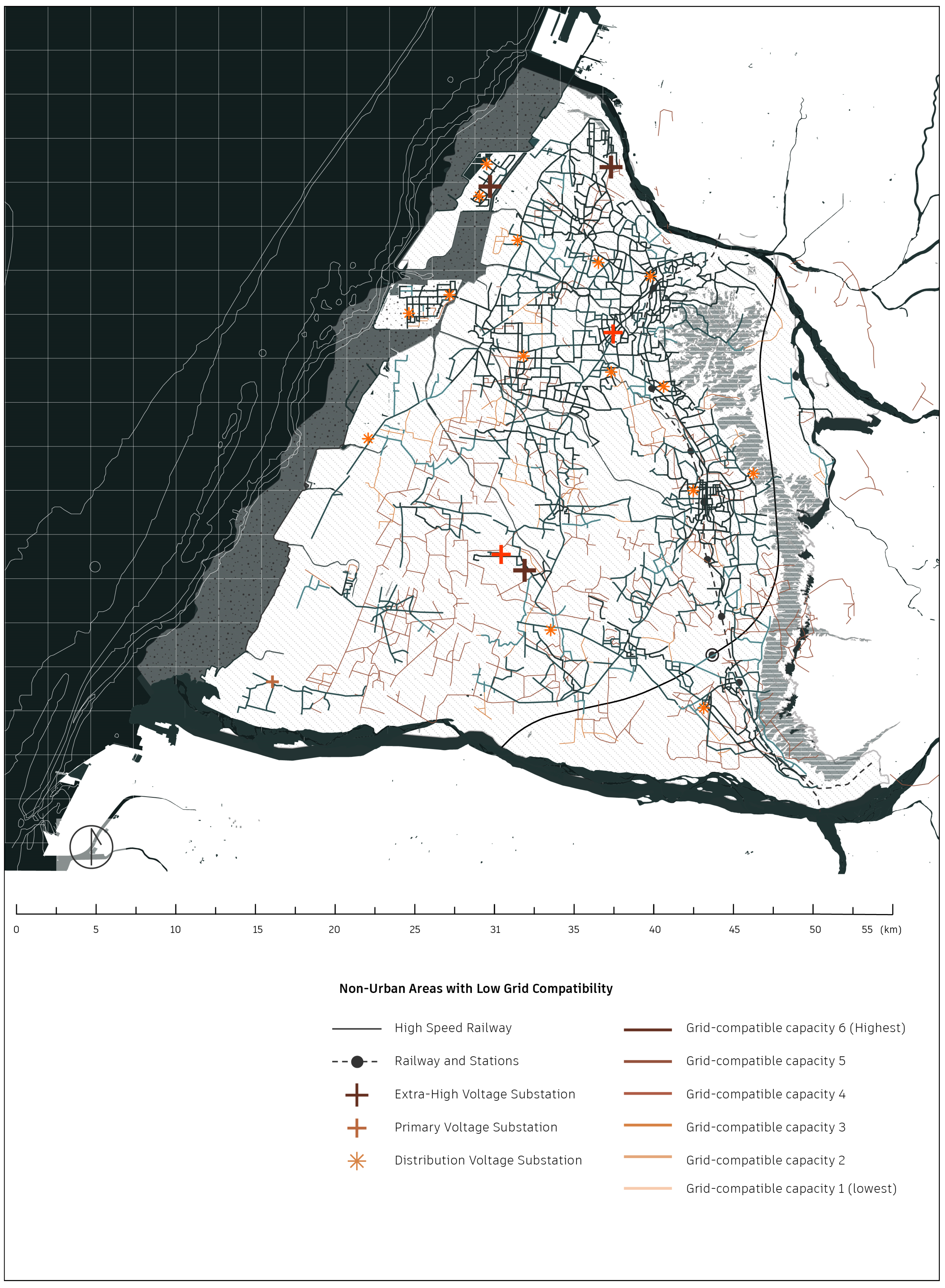
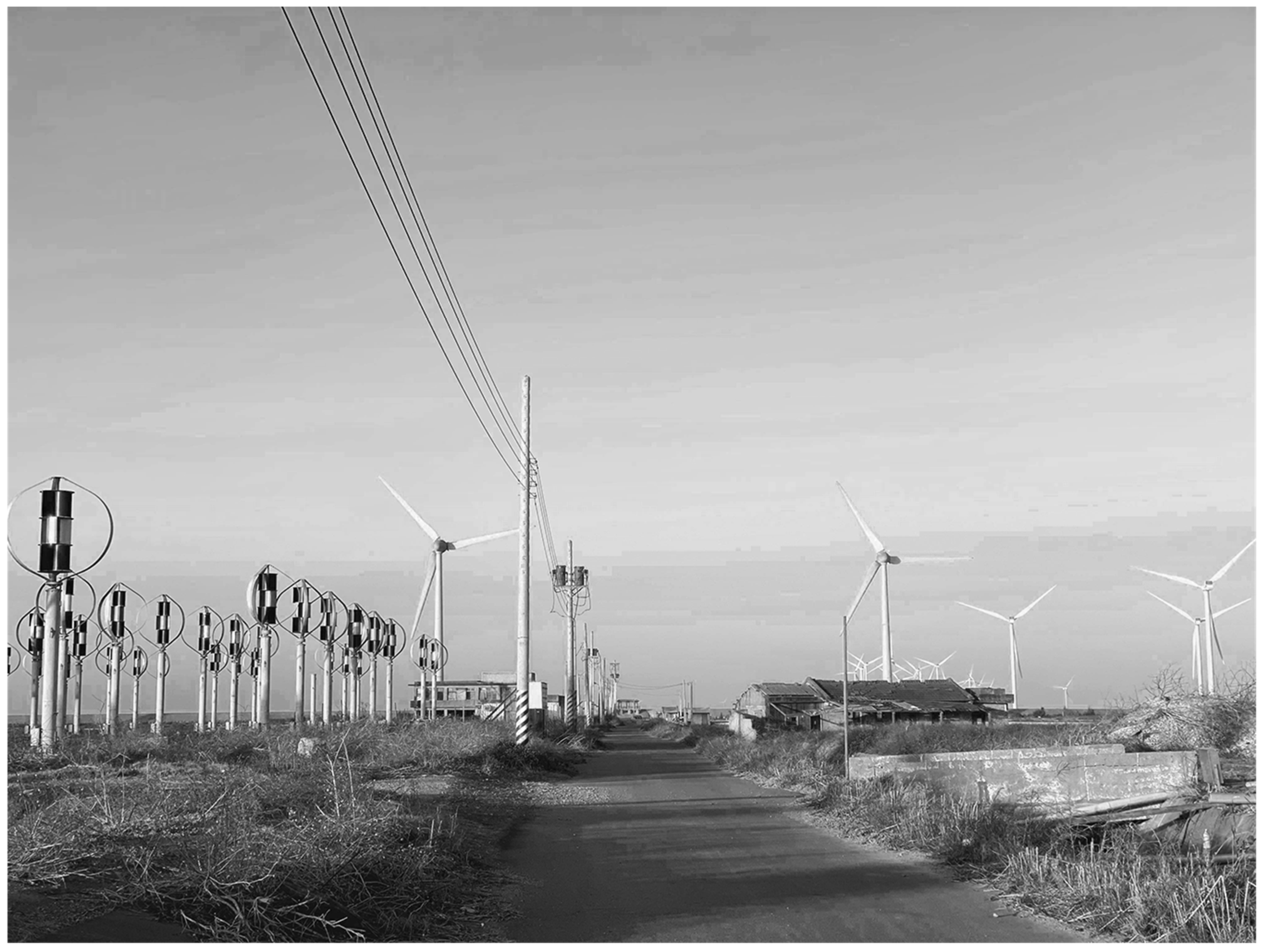
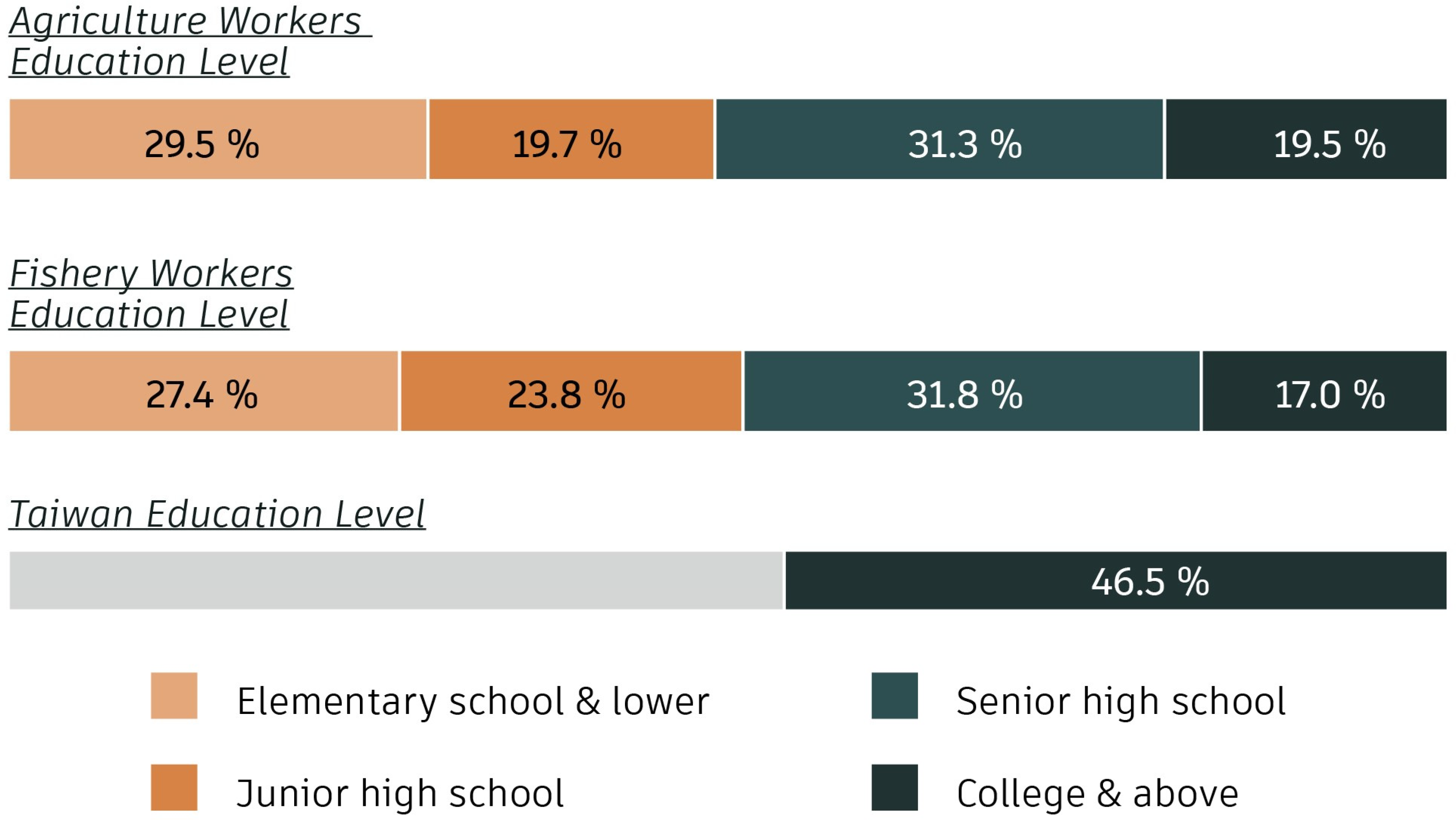
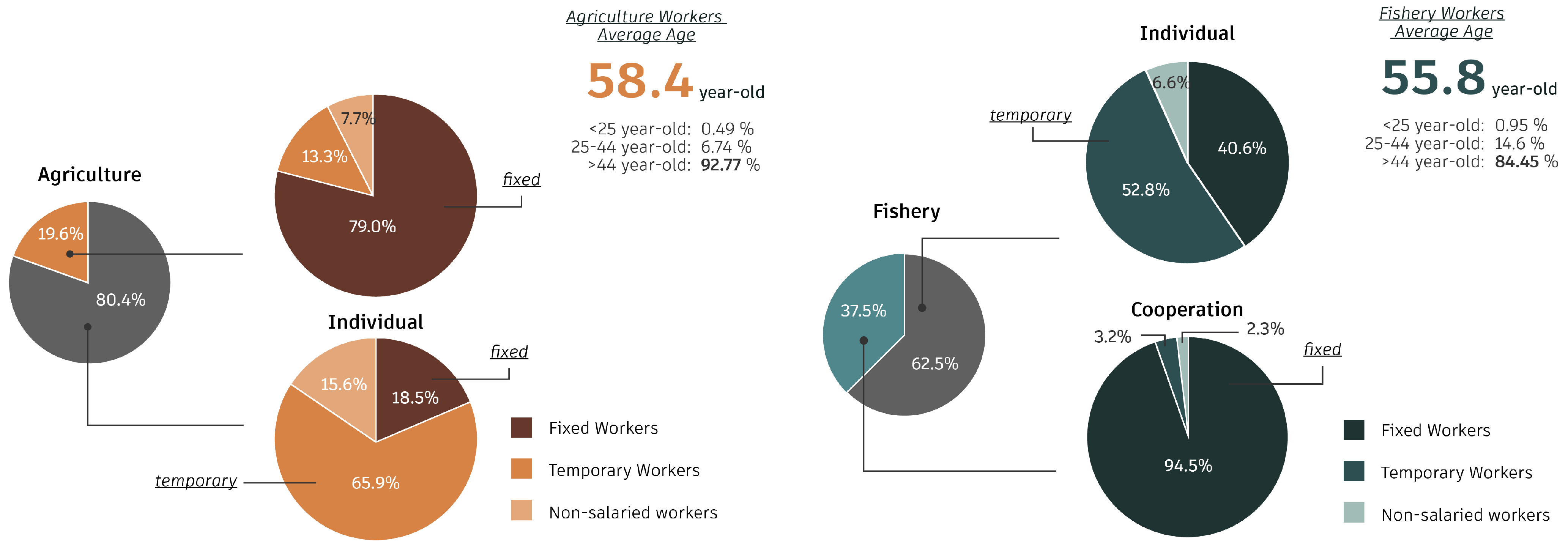
Disclaimer/Publisher’s Note: The statements, opinions and data contained in all publications are solely those of the individual author(s) and contributor(s) and not of MDPI and/or the editor(s). MDPI and/or the editor(s) disclaim responsibility for any injury to people or property resulting from any ideas, methods, instructions or products referred to in the content. |
© 2024 by the authors. Licensee MDPI, Basel, Switzerland. This article is an open access article distributed under the terms and conditions of the Creative Commons Attribution (CC BY) license (https://creativecommons.org/licenses/by/4.0/).
Share and Cite
Liu, K.-T.; Dąbrowski, M. Towards Just and Integrated Energy Transition in Taiwan: A Socio-Spatial Perspective. Land 2024, 13, 916. https://doi.org/10.3390/land13070916
Liu K-T, Dąbrowski M. Towards Just and Integrated Energy Transition in Taiwan: A Socio-Spatial Perspective. Land. 2024; 13(7):916. https://doi.org/10.3390/land13070916
Chicago/Turabian StyleLiu, Kuan-Ting, and Marcin Dąbrowski. 2024. "Towards Just and Integrated Energy Transition in Taiwan: A Socio-Spatial Perspective" Land 13, no. 7: 916. https://doi.org/10.3390/land13070916
APA StyleLiu, K.-T., & Dąbrowski, M. (2024). Towards Just and Integrated Energy Transition in Taiwan: A Socio-Spatial Perspective. Land, 13(7), 916. https://doi.org/10.3390/land13070916







